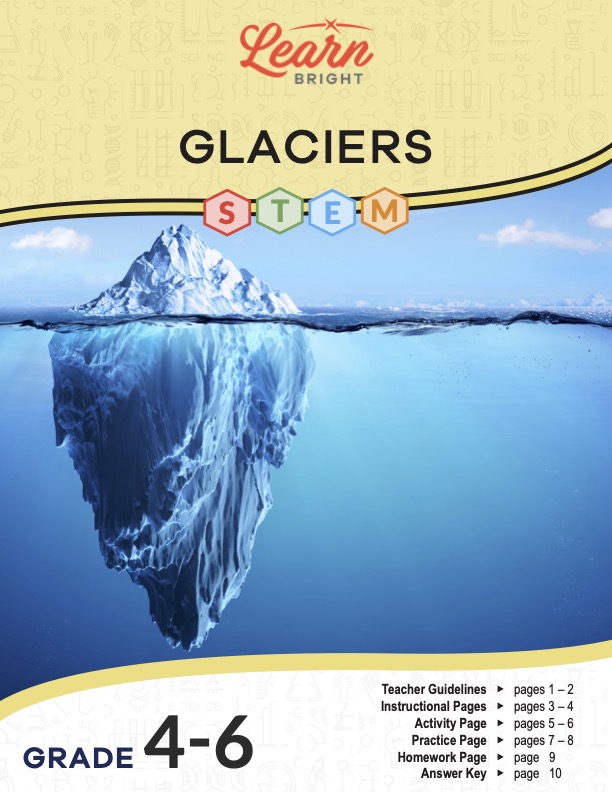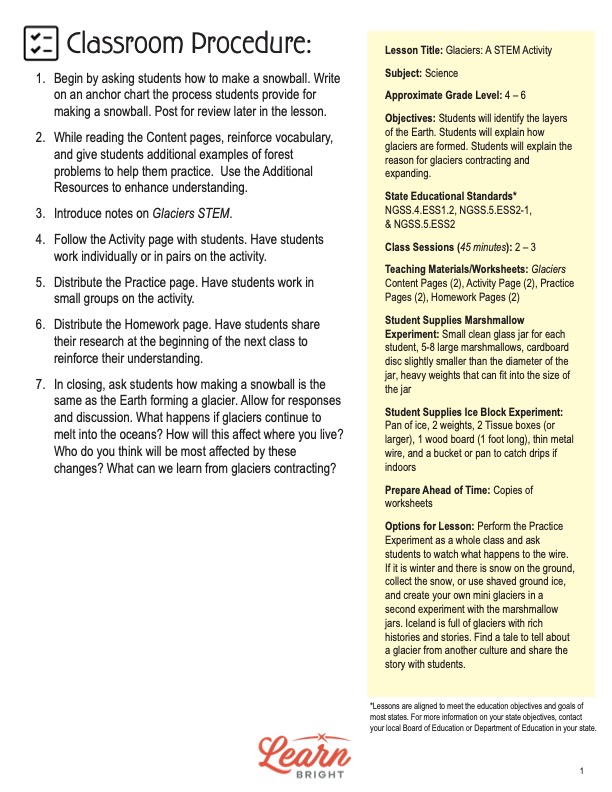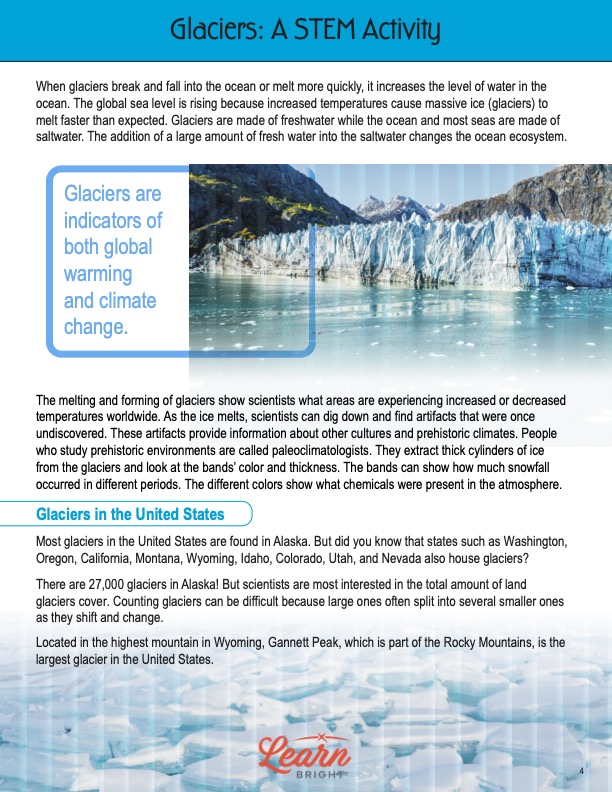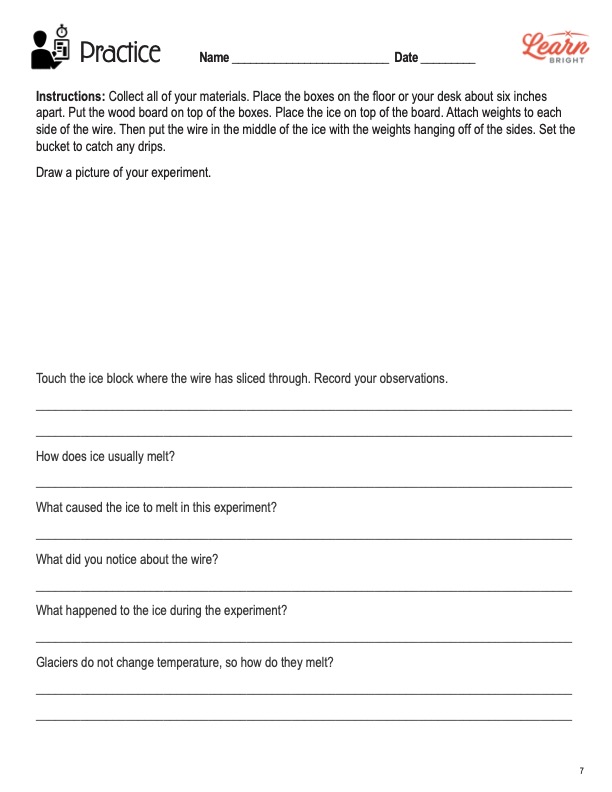Description
What our Glaciers STEM lesson plan includes
Lesson Objectives and Overview: Glaciers STEM discusses the layers of the Earth and explains how glaciers form. Students will discover why these massive ice blocks contract and expand over time. They will also demonstrate their comprehension with a hands-on activity. This lesson is for students in 4th grade, 5th grade, and 6th grade.
Classroom Procedure
Every lesson plan provides you with a classroom procedure page that outlines a step-by-step guide to follow. You do not have to follow the guide exactly. The guide helps you organize the lesson and details when to hand out worksheets. It also lists information in the yellow box that you might find useful. You will find the lesson objectives, state standards, and number of class sessions the lesson should take to complete in this area. In addition, it describes the supplies you will need as well as what and how you need to prepare beforehand. This lesson requires quite a number of materials for the experiments. For the marshmallow experiment, obtain a small jar for each student, marshmallows, cardboard discs, and heavy weights that can fit in the jar. You will also need ice, weights, tissue boxes, a wood board, thin metal wire, and a bucket or pan for the ice block experiment.
Options for Lesson
The “Options for Lesson” section of the classroom procedure page offers several additional suggestions for ideas and activities to add to the lesson plan. One optional addition is to perform the experiment on the practice worksheet as a class and ask students to watch what happens to the wire. If you teach this lesson during winter and your area has snow, collect some for an experiment. (You could also shave off some ground ice.) Have students create a mini glacier with the snow or ice as a second experiment using the marshmallow jars. One more idea is to find and share a story or tale from another culture about glaciers.
Teacher Notes
The teacher notes page provides an extra paragraph of information to help guide the lesson and remind you what to focus on. The blank lines on this page are available for you to write out thoughts and ideas you have as you prepare the lesson.
GLACIERS STEM LESSON PLAN CONTENT PAGES
What Is a Glacier?
The Glaciers STEM lesson plan contains two pages of content. Students will first discover what exactly a glacier is. Glaciers are giant, super slow-moving rivers of ice. They form in areas where there is a lot of snowfall. More precisely, the form in areas where more snow piles up than melts. When snow accumulates, it becomes very heavy. Some places actually get so much snow that it piles up over a mile high!
As it accumulates, the snow on top presses down on the snow at the bottom. It is just like packing snow between your hands to create a snowball. The weight of the snow presses down until the bottom layer turns into ice. Glaciers move very slowly from the force of gravity. While they look immobile, they are actually always on the move. Even the ice at the top of a mountain is slowly pulled down by gravity.
Two Types
There are two types of glaciers: alpine and ice sheets. Alpine glaciers are those on mountainsides. Sometimes they create valleys. These exist on every continent but Australia. Ice sheets, on the other hand, form broad domes and cover everything with a layer of ice. Large ones are called continental glaciers, like Antarctica and Greenland.
When the temperature increases, ice on the bottom of the glacier warms up. Because of this, more ice can melt, causing the glacier to move more quickly. The faster movement sometimes makes big chunks of the glacier fall into the ocean. The lesson asks students at this point what happens if a glacier falls into the ocean. There are a few blank lines for them to write their answers on.
When glaciers break and fall into the ocean, or when they melt quickly, the water levels rise in the ocean. The global sea level rises because increased temperatures cause glaciers to melt faster than expected. Glaciers are made of fresh water while the ocean and most seas have salt. The addition of a large amount of fresh water also changes the ocean ecosystem.
Glaciers and Global Warming
Glaciers are indicators of both global warming and climate change. The melting and forming of glaciers show scientists which areas of the planet are experiencing increased or decreased temperatures. As ice melts, scientists can dig down and find artifacts that were once undiscovered. These artifacts provide information about other cultures and prehistoric climates.
People who study prehistoric environments are paleoclimatologists. They extract thick cylinders of ice from glaciers and look at the various bands’ colors and thicknesses. The bands indicate how much snowfall occurred in different periods, and the colors indicate the chemicals that were present in the atmosphere at the time.
Most glaciers in the United States exist in Alaska. However, other states have them too, including Washington, Oregon, California, Montana, Wyoming, Idaho, Colorado, Utah, and even Nevada! In Alaska, there are 27,000 glaciers. However, scientists concern themselves more with the amount of land glaciers cover rather than the total number of glaciers.
Counting glaciers can be difficult because large ones often split into several smaller ones as they shift and change. Despite the fact that Alaska is home to the most glaciers in the country, the largest glacier in the United States is not in Alaska. Instead, it is on the highest mountain in Wyoming—Gannett Peak—which is part of the Rocky Mountains.
GLACIERS STEM LESSON PLAN WORKSHEETS
The Glaciers STEM lesson plan includes three worksheets: an activity worksheet, a practice worksheet, and a homework assignment. These worksheets will help students demonstrate what they learned throughout the lesson and reinforce the lesson concepts. The guide on the classroom procedure page outlines when to hand out each worksheet to your students.
MARSHMALLOW ACTIVITY WORKSHEET
For this activity, students will stack up marshmallows inside a jar. Then they will put a small cardboard disc on top of the stack. After placing a weight on the disc, they will observe and record what happens to the stack of marshmallows. They will then place more weights on the disc to see what happens. The worksheet lists four prompts to respond to regarding what they observe in the experiment.
ICE BLOCK PRACTICE WORKSHEET
Students will first place the boxes on the floor or on their desks about six inches apart. Next, they will place the wood board on top of the boxes. After placing ice on top of the board, they will attach weights to each side of the wire. Then they will put the wire in the middle of the ice so that the weights hang off the sides. They will use the bucket to catch any drips from the ice. Students will then draw a picture of their experiment and respond to several prompts on the worksheet page.
GLACIERS STEM HOMEWORK ASSIGNMENT
The homework assignment requires students to imagine they are hiking a glacier in Alaska. They will first research glaciers in Alaska that they could possibly hike in real life. Then they will list which glacier they choose to “visit” and describe why it would be exciting. Next, they will list three things they look forward to seeing on the hike. Finally, they will list various supplies they will need to pack for the trip.
Worksheet Answer Keys
There are answer keys for the three worksheets with all the correct answers in red. This will make it easier for you to compare them with students’ work. There may be some variation depending on the nature of the prompts, but many student responses should match the answer keys. If you choose to administer the lesson pages to your students via PDF, you will need to save a new file that omits these pages. Otherwise, you can simply print out the applicable pages and keep these as reference for yourself when grading assignments.









